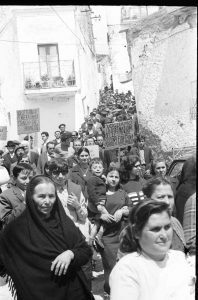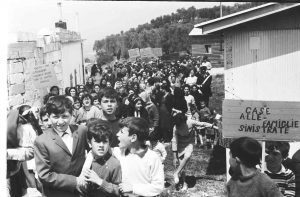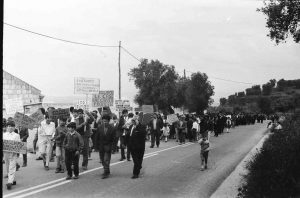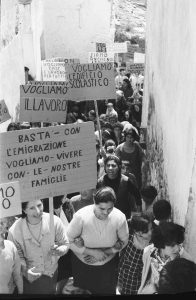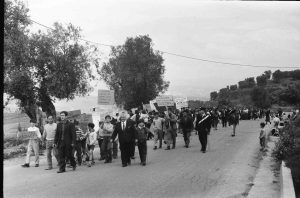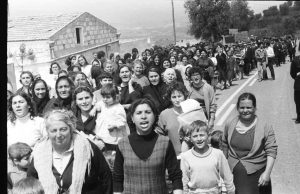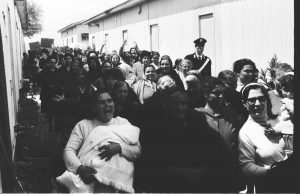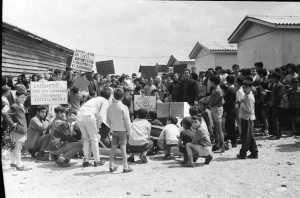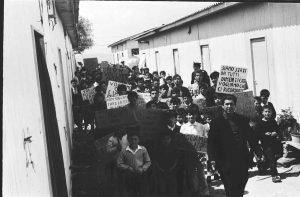The town of Craco was so profoundly impacted by the Frana that started in December 1963 that it ultimately had to be abandoned. This was a difficult and challenging change that started a new wave of emigration and the creation of the new town of Craco Peschiera. While establishing the new town there were delays which led to a series of protests. Below are recollections as recounted by Franco Rinaldi about the events:
“After the first Frana event in 1963 when land slid downstream towards the SP 103 roadway Civil Engineers intervened putting mirrors in cracks in the houses to measure changes. From 1963-64 they inserted concrete pilings in the ground and built a retaining wall. But there was no drain in the wall for water and in 1965 there was a second landslide when the wall collapsed and dragged other houses down. The mirrors placed in the houses continued breaking, a sign the landslide was still moving. The area was razed by the engineers and the houses became rubble (at present the area just looks like a square of undeveloped ground) along the roadway SP 103. People were displaced from 1963 to 1965 with the first group living in a tent city built in the square. Meanwhile, further down the valley (where the monastery is located) construction began on barracks type buildings. There was a referendum and the decision was to build housing in both Craco Vecchio and down below (where Craco Peschiera is today).
Since 1963, the municipality had been expropriating land and olive groves and began to build houses. People were placed in the barracks and the tent city remained. Meanwhile, in Craco Perschiera the construction of housing continued. As the work proceeded in Peschiera, some of the displaced people, after at least 3 years of living in shacks, were assigned a house. After the first assignment, there was a slowdown in the work of construction of the houses in Peschiera. Tired of delays the people complained and held protests in 1969-70.
The town of Craco Peschiera, although providing a new home for Cracotans also impacts the inhabitants as they can see Craco Vecchio daily.
Their feelings about the situation are reflected in a poem written by Silvana Ragone:
CRACO
IT LOOKS AT YOU FROM AFAR
HOW SHARP IS YOUR PROFILE.
IT ATTRACTS ME.
YOU LIE ALONE,
ON THE HILLSIDE.
YOUR HOUSES,
GUTTED BY THE LANDSLIDE
FROM HERE SEEM INTACT.
EVEN WHEN THE TOWER IS ALWAYS THERE
TO STRENGTHEN MY MEMORIES
I REVISIT YOU WITH MY HEART
AND FIND IN YOU
MY WHOLE LIFE.
Photographs courtesy of Pietro Colonna
UNA PROTESTA A CRACO
La città di Craco è stata profondamente impattata dallo svolgersi dei mutamenti geologici franosi che hanno preso piede dal 1963 e che ne hanno conseguito l’abbandono totale. E’ stato un cambiamento difficile e sfidante, il quale ha dato vita ad un vero e proprio movimento migratorio e la creazione del nuovo paese di Craco Peschiera.
La costruzione del nuovo paese è in realtà stata caratterizzata da diversi ritardi che portarono allo sfociare di una serie di proteste. Vogliamo riportare sotto alcune descrizioni di come si svolsero questi fatti di protesta in quel periodo, raccontati da Franco Rinaldi di Verona.
“In seguito al primo evento franoso del 1963, quando la terra scivolò verso valle fino a raggiungere la superstrada SP 103, gli ingegneri civili intervennero inserendo dei vetri tra le vessure formatasi all’interno delle case per misurarne i cambiamenti. Dal 1963 al 1965 inserirono delle colonne di cemento nel terreno e costruirono un muro di cinta. Dai muri non ci fu nessuno scarico d’acqua e nel 1965 una seconda frana conseguì la loro completa rottura, oltre al crollo di diverse unità abitative. I vetri posti all’interno delle case continuarono ad infrangersi, chiaro segno che i movimenti geologici sembravano tutt’altro che in attenuazione. L’area fu quindi abbattuta dagli ingegneri e ridotta ad un vero e proprio cumulo di macerie affacciata sulla statale SP 103 (al momento questo territorio appare come un’area quadrata di terreno non coltivato). I suoi abitanti cominciarono ad essere rilocati dal 1963 al 1965: i primi tra essi vivevano in una tendopoli eretta proprio all’interno dell’area demolita. Nello stesso momento era iniziata piu’ a valle (nei pressi del monastero) la costruzione di una baraccopoli, pronta ad ospitare un numero superiore di persone per un periodo maggiore. Ci fu quindi un referendum e la decisione unanime fu quella di costruire nuove abitazioni sia a Craco Vecchio che a valle, dove Craco Peschiera si trova al momento. Dal 1963 il comune cominciò quindi ad espropriare terreni e campi d’olivo piu’ in basso, cominciando ad edificare nuove case. Gli abitanti furono quindi posizionati nella baraccopoli che rimase per un lungo periodo in uso, mentre la costruzione di Craco Peschiera continuava. Con l’avanzare dei lavori di costruzione agli abitanti veniva assegnata una nuova unità abitativa, in seguito a circa 3 anni di permanenza all’interno di queste baracche. Dopo le prime consegne ci fu un ulteriore rallentamento dei lavori edili a Peschiera: stanchi dei ritardi e degli anni nella baraccopoli, molti cominciarono a lamentarsi, fino ad uno sfociare della protesta tra il 1969 ed il 1970.” Il paese di Craco Peschiera, nonostante simboleggi la nuova casa dei crachesi, ha tutt’ora un inevitabile e forte impatto per i suoi abitanti, i quali possono osservare quotidianamente Craco Vecchio. I loro sentimenti e le loro sensazioni circa la situazione sono riflettuti in una poesia scritta da Silvana Ragone.
CRACO
TI GUARDO DA LONTANO
È NITIDO IL TUO PROFILO,
MI ATTRAE.
SOLO GIACI,
ADAGIATO SUL PENDIO.
E LE TUE CASE,
SVENTRATE DALLA FRANA
DA QUI SEMBRANO INTATTE.
ANCHE LA TORRE È SEMPRE LÌ
A RAFFORZARE I MIEI RICORDI.
ED IO TI RIVISITO CON IL CUORE
E RITROVO IN TE
TUTTA LA MIA VITA.
Cortesia fotografica di Pietro Colonna
